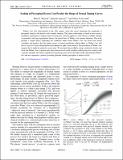Scaling of Perceptual Errors Can Predict the Shape of Neural Tuning Curves
Author(s)
Shouval, Harel Z.; Agarwal, Animesh; Gavornik, Jeffrey
DownloadShouval-2013-Scaling of perceptual errors can predict the shape of neural tuning curves.pdf (260.4Kb)
PUBLISHER_POLICY
Publisher Policy
Article is made available in accordance with the publisher's policy and may be subject to US copyright law. Please refer to the publisher's site for terms of use.
Terms of use
Metadata
Show full item recordAbstract
Weber’s law, first characterized in the 19th century, states that errors estimating the magnitude of perceptual stimuli scale linearly with stimulus intensity. This linear relationship is found in most sensory modalities, generalizes to temporal interval estimation, and even applies to some abstract variables. Despite its generality and long experimental history, the neural basis of Weber’s law remains unknown. This work presents a simple theory explaining the conditions under which Weber’s law can result from neural variability and predicts that the tuning curves of neural populations which adhere to Weber’s law will have a log-power form with parameters that depend on spike-count statistics. The prevalence of Weber’s law suggests that it might be optimal in some sense. We examine this possibility, using variational calculus, and show that Weber’s law is optimal only when observed real-world variables exhibit power-law statistics with a specific exponent. Our theory explains how physiology gives rise to the behaviorally characterized Weber’s law and may represent a general governing principle relating perception to neural activity.
Date issued
2013-04Department
Picower Institute for Learning and MemoryJournal
Physical Review Letters
Publisher
American Physical Society
Citation
Shouval, Harel Z., Animesh Agarwal, and Jeffrey P. Gavornik. Scaling of Perceptual Errors Can Predict the Shape of Neural Tuning Curves. Physical Review Letters 110, no. 16 (April 2013). © 2013 American Physical Society
Version: Final published version
ISSN
0031-9007
1079-7114